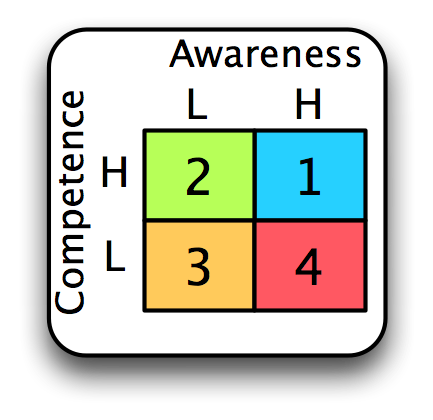I have found that if you want to change an organization, do not dismiss the importance of a shared vocabulary. These purposeful words can often turn out to be very simple ways to express complex concepts – concepts that represent a common understanding developed among the members of a team. Let me give an example.
This grid is often called the Conscious Competence Matrix. It describes the sequential states that exist in learning and mastering new ideas. As a quick summary, learning starts in the fourth quadrant (Q4), known as “I don’t know what I don’t know”, proceeding to “I know what I don’t know”, “I know what I know” and ends at Q1, “I don’t know what I know”.
I feel it is important for everyone on my team to understand this important concept and how it plays into their decision making and attitudes about knowledge acquisition. When I originally taught this, I consciously reiterated the Q1, Q2, Q3 and Q4 labels. For the next couple of weeks it felt like the time when I got that word of the day calendar and I tried to interject it into any conversation possible. Yes it is a little contrived, but it works.
After about a month I overheard someone say to a team member “This is a Q4 to Q3 problem. In order to reduce risk we need to focus on discovering what we don’t know as soon as possible and then we can figure out what we need to learn about all of these new Q3 items.”
How cool!
The key here is that the receiver of the message instantly recognized the complex concept with only one letter and one number. It was simple to communicate because they shared a simple vocabulary. Imagine how cumbersome it would have been to try and explain it without these labels.
And we all know that the simpler something is, the more likely it will be used.
Today’s Question:
Do you purposefully build a shared vocabulary or is it the natural byproduct of your work environment?







